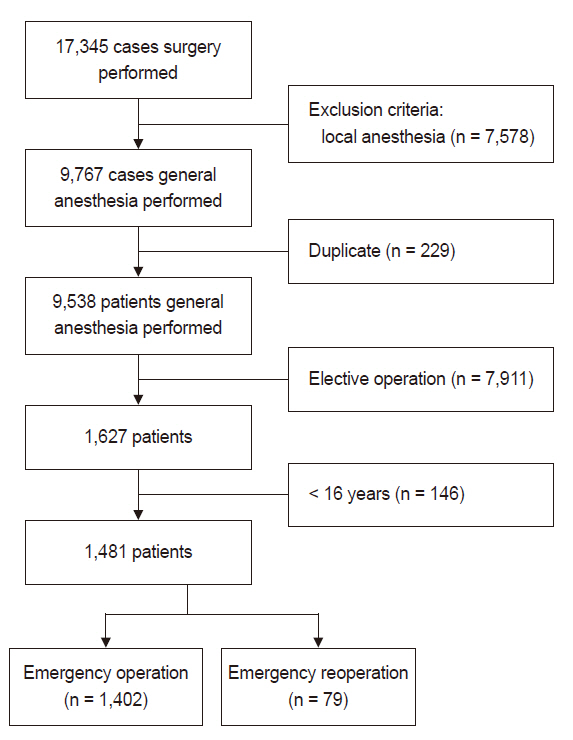Anesth Pain Med.
2020 Apr;15(2):233-240. 10.17085/apm.2020.15.2.233.
Risk factors of emergency reoperations
- Affiliations
-
- 1Department of Anesthesiology and Pain Medicine, Bucheon St. Mary's Hospital, College of Medicine, The Catholic University of Korea, Bucheon, Korea
- KMID: 2500977
- DOI: http://doi.org/10.17085/apm.2020.15.2.233
Abstract
- Background
Emergency reoperation is considered to be a quality indicator in surgery. We analyzed the risk factors for emergency reoperations.
Methods
Patients who underwent emergency operations from January 1, 2017, to December 31, 2017, at our hospital were reviewed in this retrospective study. Multivariate logistic regression was performed for the perioperative risk factors for emergency reoperation.
Results
A total of 1,481 patients underwent emergency operations during the study period. Among them, 79 patients received emergency reoperations. The variables related to emergency reoperation included surgeries involving intracranial and intraoral lesions, highest mean arterial pressure ≥ 110 mmHg, highest heart rate ≥ 100 /min, anemia, duration of operation >120 min, and arrival from the intensive care unit (ICU).
Conclusions
The type of surgery, hemodynamics, hemoglobin values, the duration of surgery, and arrival from ICU were associated with emergency reoperations.
Figure
Reference
-
1. Wain MO, Sykes PA. Emergency abdominal re-exploration in a district general hospital. Ann R Coll Surg Engl. 1987; 69:169–74.2. Unalp HR, Kamer E, Kar H, Bal A, Peskersoy M, Ali Onal M. Urgent abdominal re-explorations. World J Emerg Surg. 2006; 1:10.3. Guevara OA, Rubio-Romero JA, Ruiz-Parra AI. Unplanned reoperations: is emergency surgery a risk factor? A cohort study. J Surg Res. 2013; 182:11–6.4. Tera H, Aberg C. Relaparotomy. A ten-year series. Acta Chir Scand. 1975; 141:637–44.5. O'Leary DP, Hardwick RH, Cosford E, Knox AJ. Does hospital mortality rate reflect quality of care on a surgical unit? Ann R Coll Surg Engl. 1997; 79:46–8.6. Harbrecht PJ, Garrison RN, Fry DE. Early urgent relaparotomy. Arch Surg. 1984; 119:369–74.7. Copeland GP. The POSSUM system of surgical audit. Arch Surg. 2002; 137:15–9.8. Donati A, Ruzzi M, Adrario E, Pelaia P, Coluzzi F, Gabbanelli V, et al. A new and feasible model for predicting operative risk. Br J Anaesth. 2004; 93:393–9.9. Matsuyama T, Iranami H, Fujii K, Inoue M, Nakagawa R, Kawashima K. Risk factors for postoperative mortality and morbidities in emergency surgeries. J Anesth. 2013; 27:838–43.10. Kwinta BM, Krzyżewski RM, Kliś KM, Donicz P, Gackowska M, Polak J, et al. Emergency reoperations in cranial neurosurgery. World Neurosurg. 2017; 105:749–54.11. Davies AH, Pope I, Collin J, Morris PJ. Early reoperation after major vascular surgery: a four-year prospective analysis. Br J Surg. 1992; 79:76–8.12. Brant JA, Bur AM, Chai R, Hatten K, Nicolli EA, Fischer JP, et al. Reoperation following adult tonsillectomy: review of the American College of Surgeons National Surgical Quality Improvement Program. Otolaryngol Head Neck Surg. 2016; 154:779–84.13. Ramachandran R, Hegde T. Chronic subdural hematomas--causes of morbidity and mortality. Surg Neurol. 2007; 67:367–72.14. Lee DI, Lee MH, Shin OY, Shin KY. A clinical study of anesthesia for emergency surgery. Korean J Anesthesiol. 1979; 12:252–60.15. Ching SS, Muralikrishnan VP, Whiteley GS. Relaparotomy: a five-year review of indications and outcome. Int J Clin Pract. 2003; 57:333–7.16. Irita K. Risk and crisis management in intraoperative hemorrhage: human factors in hemorrhagic critical events. Korean J Anesthesiol. 2011; 60:151–60.
- Full Text Links
- Actions
-
Cited
- CITED
-
- Close
- Share
- Similar articles
-
- Emergency Medicine in Disasters
- Risk Factors for Delirium in Elderly Patients Visiting an Emergency Department
- Perception of the Patient Safety Risk Factors and Safety Management by Nurses in Emergency Service, Hospitals
- Minimally Invasive Approaches in Reoperations after Conventional Craniotomies : Case Series
- A Clinical Analysis of Intermittent Exotropia Patients Requiring More than Three Reoperations


